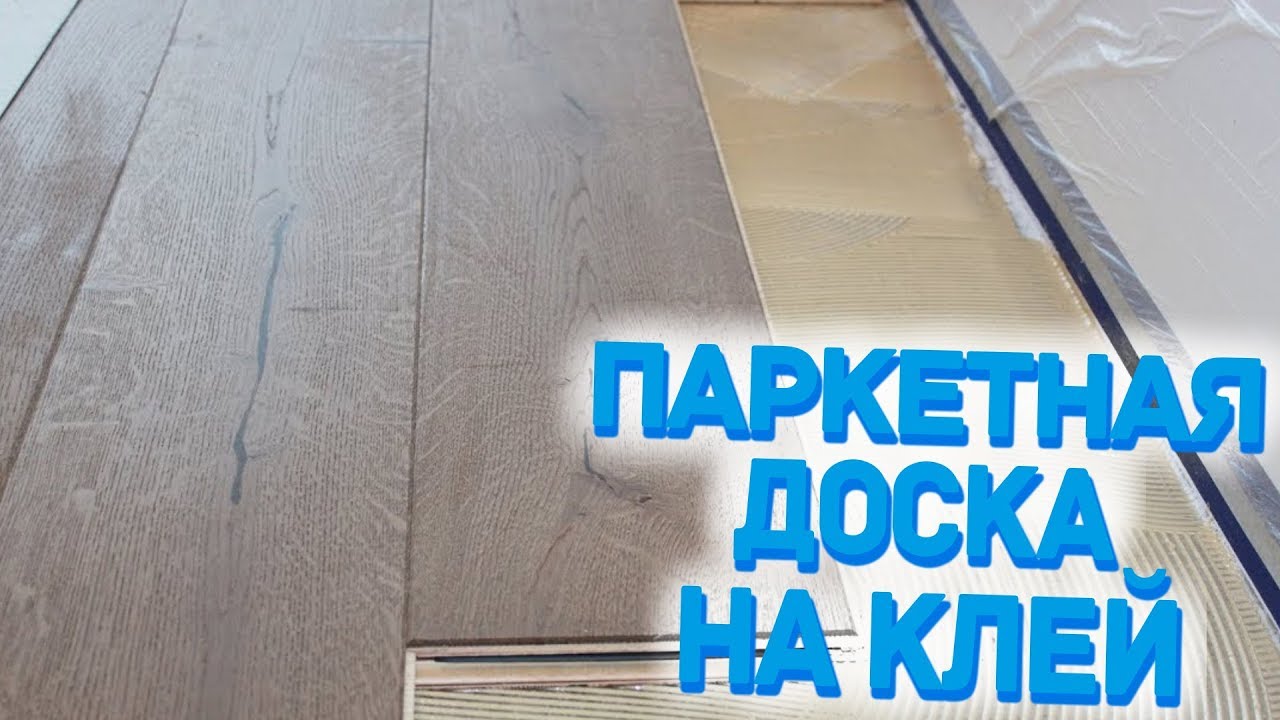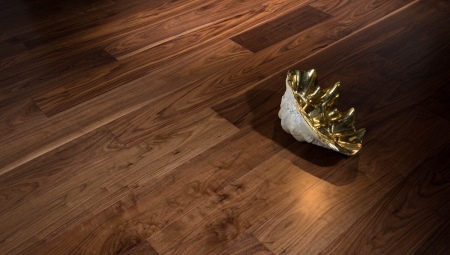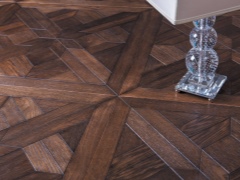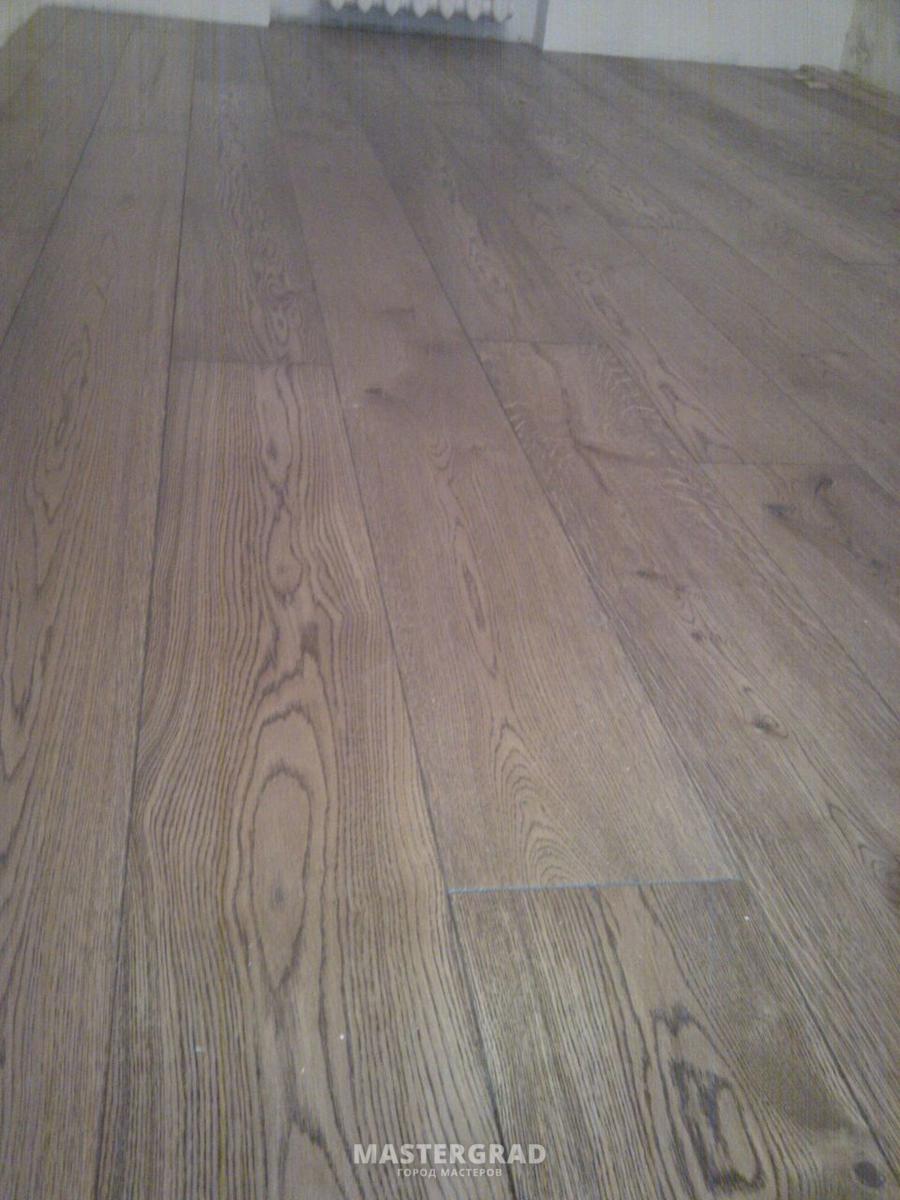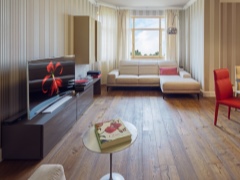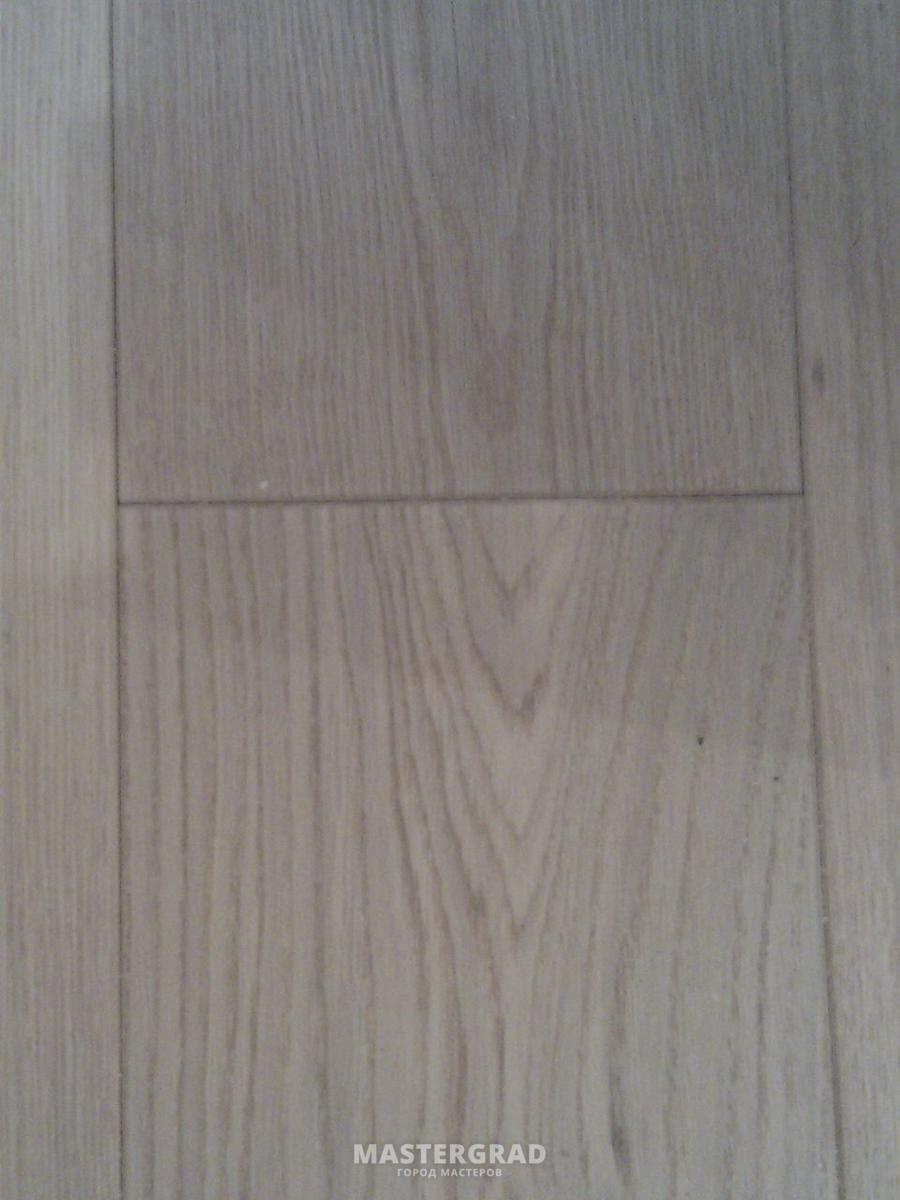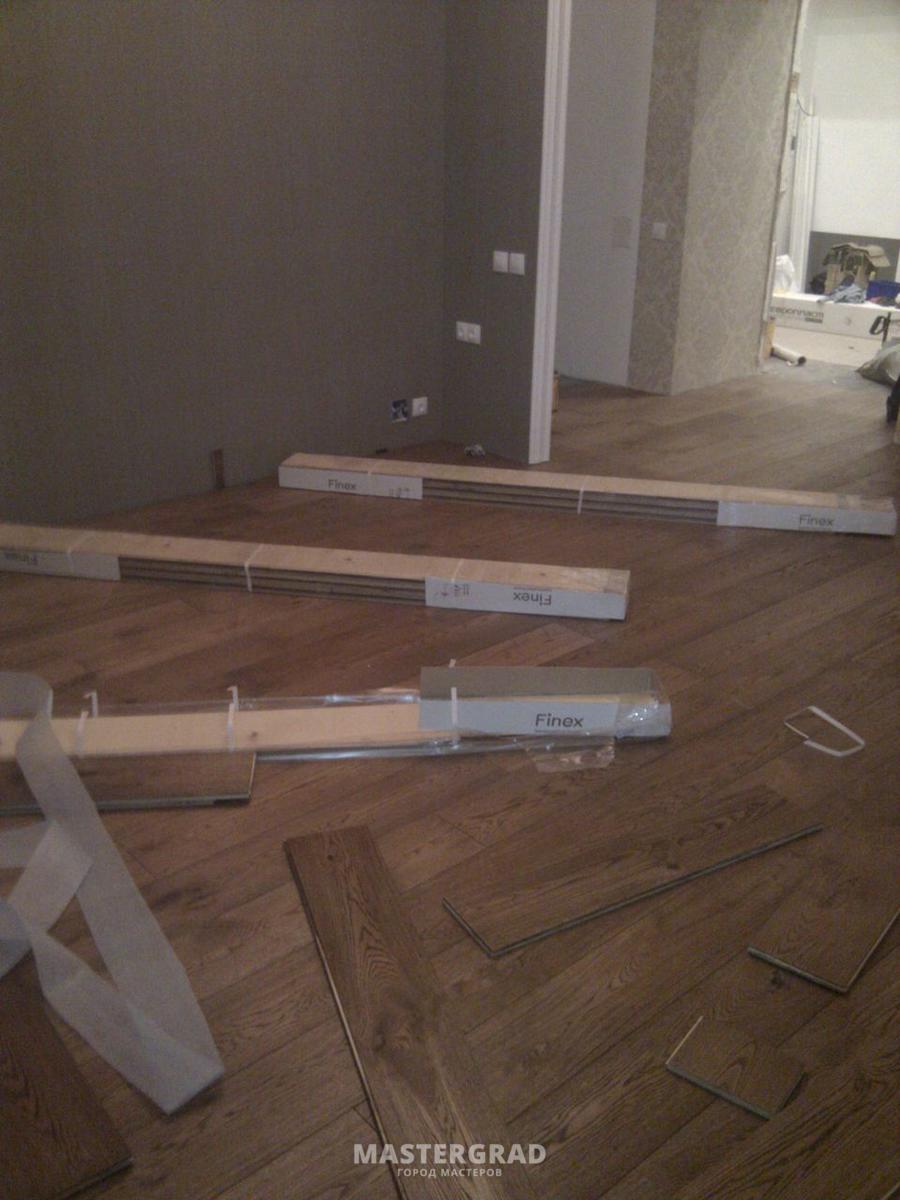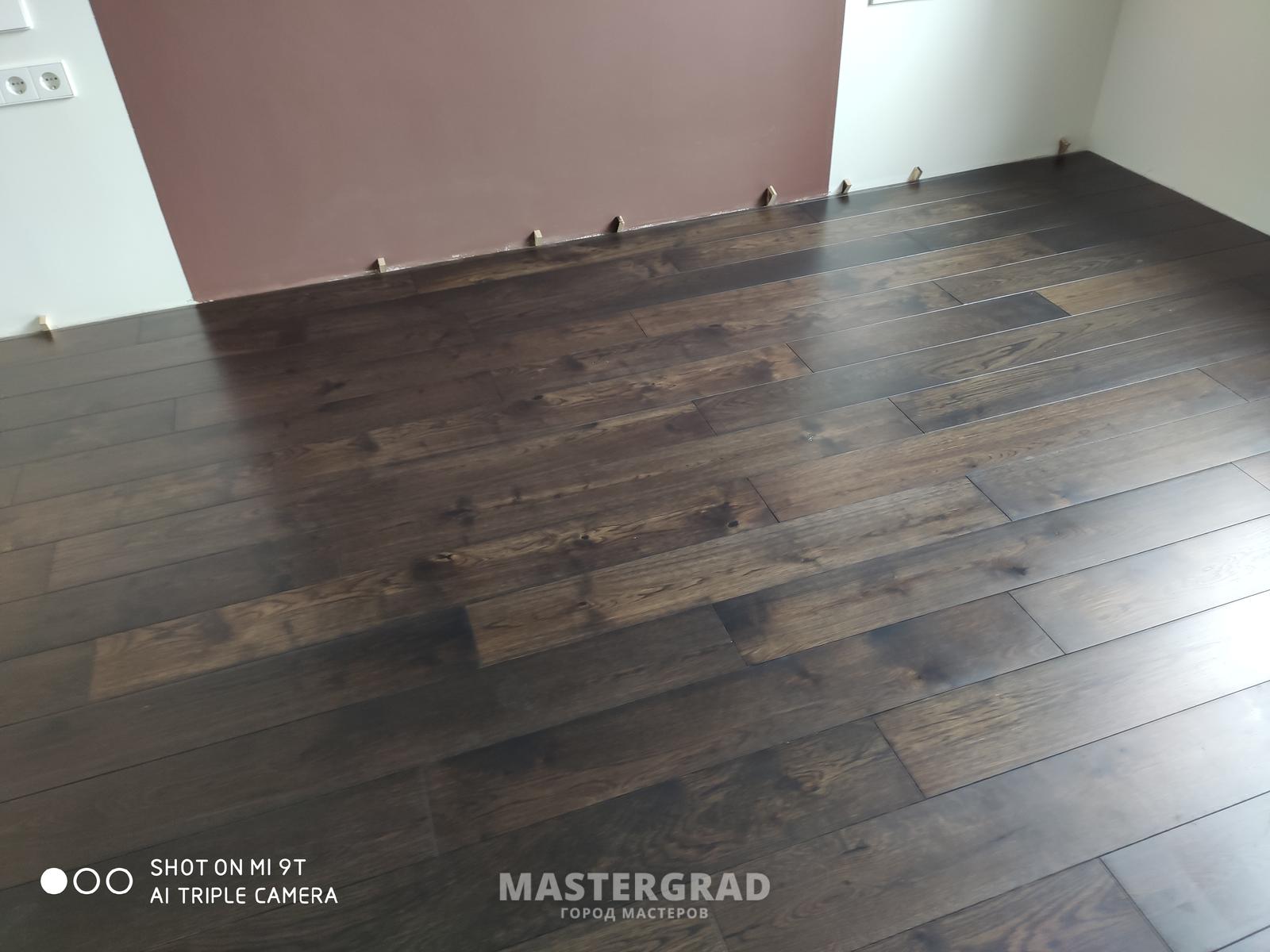Main manufacturers and texture of engineering boards: oak, fir-tree, walnut and others
Engineering board Wood Bee is popular among consumers of the Russian market, because it has an optimal price-quality ratio. The material of the Dutch manufacturer is made in cooperation with Chinese companies, which makes it possible to obtain a product available to almost every buyer at the exit. In terms of quality, the board meets European standards, and the coating itself is distinguished by various stylistic solutions and a large selection of textures. Among the disadvantages, users note some softness of the coating, on which traces remain from falling metal objects, as well as the appearance of dents from the legs of furniture.
Engineered board of the Dutch brand Wood Bee has an excellent value for money
Finex engineering board of the Russian manufacturer is presented in a wide range of shades and textures. It is also possible to create various effects, for example, aged wood, which is achieved by using manual processing technology:
- gouging;
- planing;
- brushing.
In order not to lose color during use, smoking and staining methods are used, allowing the color to penetrate deep into the wood. An additional protective layer is provided by treatment with hard wax oil and a special varnish. The manufacturer gives a guarantee for the product for 25 years, because in the manufacture they use ultra-strong and elastic adhesive mixtures that can withstand a 10-hour stay in boiling water.
Other Popular Engineer Board Manufacturers
Coswick engineering board is based on plywood, which does not deform when exposed to high temperatures. It is this fact that allows the material to be laid on top of the underfloor heating system. Even when heated, the board does not emit any harmful substances that can affect the health of the residents.
The Russian company Finex offers its customers a rich color range of products
All products of the company have European certificates of environmental safety E1, which indicates the absence of formaldehyde in the composition. The board is distinguished by its ability to withstand all kinds of mechanical stress. Strength is ensured due to the fact that the base is moisture-resistant plywood made of birch. The material has a low cost.
Topwood is a Croatian brand that has been on the market for over 20 years. The main direction of the company is the preservation of the natural properties of wood. Therefore, the entire assortment accurately conveys the rich woody pattern and shade of natural wood. The company, thanks to full-cycle enterprises, supplies to store shelves goods of the correct geometry, of the same grade, with good characteristics. Engineered board walnut, oak and other options are available for purchase. The only drawback is the high cost of the material, but in terms of operation, there are no negative customer reviews.
The Swiss company Bauwerk offers high quality products that are in great demand among customers. The thickness of the engineered floor board is only 11 mm. In addition, the company offers products with unique shapes and colors that cannot be found in other manufacturers.
Lab Arte engineering board is supplied by a domestic company that harvests mature hardwood oak from ecologically clean regions of the foothills of the Greater Caucasus. In production, the material undergoes a number of technological operations:
Coswick engineering board is perfect suitable for installation on a warm floor
- sawing;
- drying;
- calibration;
- profiling;
- coating with varnish or oil;
- drying.
The manufacturer guarantees the high quality of the goods, because at each stage the product undergoes strict control necessary to confirm compliance with the technical conditions.
NATURA engineered vinyl flooring is distinguished not only by its excellent technical characteristics, but also by its exceptional appearance. The Belgian manufacturer guarantees 100% water resistance of the coating, which is achieved thanks to a large number of additional layers, such as:
- UV;
- polyurethane;
- decorative - in the form of a film that imitates the texture of wood;
- vinyl.
From Bauwerk you can purchase an engineered board in a unique color or texture
It is the presence of a vinyl layer that ensures the constancy of geometric characteristics, regardless of humidity and temperature drops.
Technical description, structure and material
The board consists of the following layers:
- The first layer is the base of the material. For its creation, multilayer birch plywood of the highest grades is usually used, since it has high moisture resistance. Depending on the manufacturer, the thickness of this layer is in the range of 6–16 mm, but in some cases it can be even more. It is on this layer that the lock connection is made.
- Middle layer. It provides higher strength and reliability. To create it, coniferous wood is most often used, which is located perpendicular to the other two layers.
- Face layer. For its manufacture, valuable species of wood are used, it can be maple, beech, oak, ash. The thickness of this layer ranges from 2.5 to 7 mm. The thicker it is, the greater the durability of the board.
 The thicker the front layer, the more times such a coating can be restored.
The thicker the front layer, the more times such a coating can be restored.
The thickness of the face layer determines how many times the material can be restored; it must be borne in mind that about 1 mm of the coating is removed at a time.
The size range will be much wider than that of floor coverings of similar appearance. The parameters of the engineering board are as follows:
- the length can be in the range of 0.5 -3 m, it is possible to make boards 6 meters long, but this complicates the process of material delivery;
- width in the range of 10–45 cm, but most often an engineering board with a width of 15–30 cm is used;
- the thickness depends on the thickness of the layers and is usually in the range of 12–25 mm.
 The width and length of an engineered board can be more than a massive one, because there are few large and thick trees
The width and length of an engineered board can be more than a massive one, because there are few large and thick trees
Depending on what kind of wood the front layer is made of, the color and structure of the material depends. In order to further emphasize the structure of the wood and increase the wear resistance of the surface, varnish or wax and oil compositions are used as a topcoat. Some manufacturers, in order to achieve an interesting decorative effect, carry out scraping or firing of the front layer.
Most often, boards are made in a standard rectangular shape. If necessary, you can make curved elements, with the help of which an original and unique flooring is obtained.
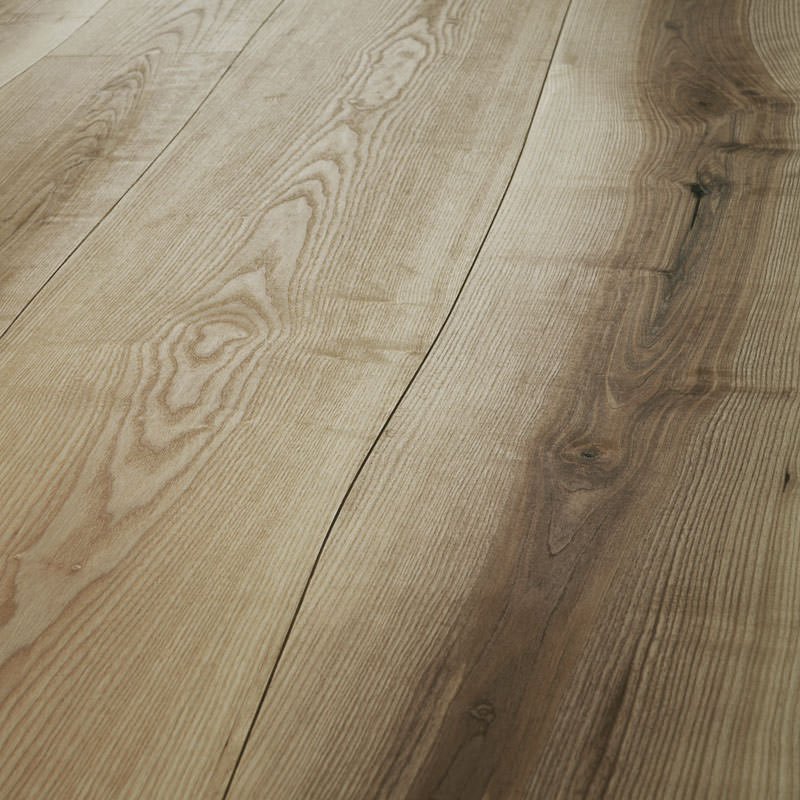 Curved elements allow you to create original solutions
Curved elements allow you to create original solutions
This is a modern material, the production process of which consists of the following stages:
- Lamellas of a given thickness are cut from the selected wood on special machines.
- Plywood is prepared according to the required dimensions.
-
With the help of special glue, all layers of the engineering board are connected into a single structure. Everything happens under the influence of a press, which ensures high adhesion of the layers and stable geometric parameters of the boards.
- At the ends of the elements, a lock connection is made, the most common variant of the "thorn-groove", but there may be others.
- Finish coating. Most often, an engineering board is varnished to obtain a high-quality surface, the number of its layers should be at least five. In addition to varnish, elements can be coated with wax or special oils.
To make the face layer, wood is cut in different ways:
- at different angles - a rustic way of cutting;
- tangential to the thickness of the trunk - tangential method;
- along the grain - a radial cut.
After that, the resulting material is distributed according to the cutting method and according to the presence of various defects, the texture and color are also taken into account.
There are such types of engineering board:
-
Rustic grade. Rustic wood is used for the top layer of this material. Such an engineered board may have a different texture and color, as well as minor defects. It has a low cost, looks natural, and therefore is the most popular.
-
Variety "Natur". For its manufacture, lamellas are used, obtained by the radial and tangential cutting method. Here, differences in color and texture are minimal and there are practically no defects. This material belongs to the middle price category.
-
Variety "Select". For the manufacture of such material, lamellas obtained by radial sawing are used. Their color and texture match perfectly, and there are no defects. The cost of such material is maximum.
To ensure dimensional stability and to compensate for the resulting stresses, some manufacturers make numerous cuts on the bottom of the engineered board.
What determines the price of engineering coating?
Before finding out how much the engineering flooring of a particular manufacturer costs, let's figure out what the price of this material depends on. Several factors affect the cost of elements:
- The type of wood used for the production of the face layer. The most inexpensive boards are obtained from traditional woods - oak, ash, cherry, maple, etc. The most expensive products are made from exotic species - merbau, wenge, cougar, teak, American walnut, sapele, etc. The assortment of Finex, Wood Bee, Coswick, Marco Ferutti and other well-known companies includes products from different breeds.
- Design features. All elements of this variety can be divided into two types: two-layer and three-layer. Naturally, you will have to pay more for the three-layer version, because in it all three layers are made from deciduous trees. Usually the top layer is a valuable species, and the rest of the layers are made from budget timber. In addition, the thickness of the three-layer floor is greater. It reaches 20-25 mm. The basis of a two-layer board, for example, Wood Bee, is a moisture-resistant multi-layer plywood. Only the top layer of such products is made of valuable wood, so the purchase costs will be lower.
- Protective covering. The cost of engineering, like parquet boards, is influenced by the type of protective coating. So, to protect the engineered floor in the factory, a varnish coating or oil impregnation is applied. Thus, after installing the flooring, you do not need to spend money on the purchase of special tools. The most expensive is a multi-layer coating made of wear-resistant varnish that hardens under ultraviolet rays. It can be matte, glossy, satin, with a toning or whitening effect. Oil impregnation is usually applied to brushed boards to enhance the beauty of the wood grain. It can also be with a whitening or toning effect, with a matte or semi-matte surface.
- Fixing connection type. To collect all floor elements into a single coating, a fixing mechanism is cut at the ends of the engineered board. There are two types of them: "thorn-groove" and a special lock connection, like a parquet board. The first type of lock allows installation only by the glue method, so the cost of such flooring will turn out to be higher due to the cost of purchasing glue. Products with such a lock are presented in the assortment of Finex. Lock planks are more expensive, but also more practical and convenient to use, since they can be installed without gluing to the base, which will save on the purchase of glue.In addition, if necessary, such a floor can be disassembled and laid in a new place, and it is also easy to replace a worn-out element. In addition, the installation of the board in a floating way is easy to do with your own hands, which will allow you to save on paying for the work of the stackers. Lock jointed boards can be found in the range of Wood Bee.
- Design options. Depending on the design of the board and its decorative processing, the price of the coating may increase. For example, brushed boards with an aged surface, like tinted elements, are more expensive than products of natural color and texture. But the processed engineering board, like the parquet board, looks more expensive and respectable. You can choose the coating for any style and color of the interior. For example, Wood Bee brushed oak planks can be installed in country, fusion, chalet, Provence-style rooms, while Finex smooth bleached oak flooring is suitable for classic and modern styles.
- Product dimensions. An engineered board can be wider than a parquet floor. The thing is that the plywood base protects the floor from deformation and gives the board of any size geometric stability in any operating conditions. That is why the assortment of most manufacturers (Finex, Wood Bee, Coswick, Marco Ferutti, etc.) includes boards with different dimensions. The wider the product, the more expensive it is. However, the thickness of the product also affects the price of the coating. Thickened floors are more expensive because they are stronger and more durable.
- Manufacturer. Also, the price depends on the manufacturer. The popularity of the brand, the raw materials used, the features of the production equipment and many other factors affect the cost of the manufactured products.
Why Finex
Finex products are manufactured at the own production facility of the Finex company, equipped with the latest European equipment.
Production sites are located in Russia (Klin, Moscow region), as well as in Austria and Belgium.
The highest quality European oak is used for the production of the floors.
Drying of wood in Finex is carried out according to the first quality category without internal stresses, which allows us to give a guarantee for structural integrity up to 25 years
The board is processed on specialized Weinig machines (Germany). The quality of workmanship and the unique profile of the Finex board ensure that there are no gaps and
unevenness on the floor after installation
In the production of boards, staining and smoking technologies are widely used, due to which the color penetrates deeply into the wood and does not "wipe" during operation
The finishing coat involves layers applied both manually and on an automated painting line, which allows you to achieve high quality and maximum
durability of floors. The following are used as a protective coating for solid boards: oil with hard wax (Germany), varnish (Sweden, Germany). Technological cycle
coverage includes up to 23 operations
Modular parquet is produced on numerically controlled machines (and not using miter saws, as a number of other manufacturers do), which provides
perfect geometry of modules and absence of gaps between elements
In the production of multilayer boards, cold pressing is used, which ensures the highest quality of gluing, because wood is not subject to deformation, and in
it does not generate stresses after pressing, which are always present during hot pressing
In the production of a multi-layer board, ultra-strong and flexible adhesives of a new generation are used, which are several times more expensive than adhesives based on resins or PVA and have the most
the best indicators for environmental friendliness and viability (a board glued with such glue can withstand 10 hours in boiling water without visible signs of delamination, which is equivalent
more than 40 years of operation in conditions of varying humidity and temperature)
Finex carries out a full cycle of works with floors:
Development of individual design and floor design (the object of the design application can be the board itself, individual modules or the floor as a whole).
Board production: sawing, drying, gluing layers (in the manufacture of a multi-layer board), mechanical surface treatment (smoking, staining, wood dyeing
natural pigments, manual surface treatment and industrial topcoating).
Parquet works: floor installation, service and maintenance (in stock - all related products for installation and maintenance: self-tapping screws, glue, plywood, sealant, care products
and restoration of floors).
By managing the entire production cycle, we can guarantee you delivery times and the quality of the laid floor.
We produce planks, modular parquet and decorative floors in various designs, so you can choose the best option for residential or public
premises
Prices for Finex products are 1.5-2.5 times lower than those of European counterparts. Not a single Russian manufacturer manufactures products of similar quality
Choosing Finex, you choose the leader in the design of natural wood flooring
Huge selection of colors and textures of the board
Various board widths and selections
Various effects of noble aging of the board, which are achieved using manual processing technologies (cutting, planing, brushing, etc.)
Various sizes and configurations of modules
Reflection in floor coverings of the most current trends in interior design
Finex products are manufactured at the own production facility of the Finex company, equipped with the latest European equipment.
Pros and cons of the board
Every flooring has its own distinctive pros and cons. Therefore, before purchasing an engineering board, you should carefully study all its features. This is far from parquet, wood board, laminate or boardwalk. The difference between them seems insignificant only at first glance.
It is not for nothing that for novice craftsmen it is often much easier to figure out how to choose interior doors or certain windows into the house. The wooden finish on the floor must be selected with greater care. Outwardly, the tree looks beautiful and elegant, but with the wrong selection of material or mistakes in installation, it will not last long.
Due to the multilayer structure of dense plywood sheets, the engineered board dampens sounds much better than solid parquet strips or laminate planks. Plus, unlike the laminated version, it looks more natural and beautiful.

Engineering board in the interior
The price per square meter of varnished engineering board starts from 2 thousand rubles. And the thicker the veneer layer, the more expensive the coating will cost. Plus money for glue. As a result, it comes out quite expensive. However, all these costs pay off due to the durability of the finish and the ability to easily restore it when the need arises.
Finishing a solid board
The richness of the choice of color solutions for a solid board is not limited to its natural color. To enhance the color of a massive parquet board, tinting compounds are used, such as varnishes, oils, glazes and many others (the procedure is called tinting). With these tools, you can give your solid board any color you want - white, blue-gray or radical black - the choice of shades is endless. This processing option is suitable for connoisseurs of design and for those who would like to purchase a coating from exotic species, but cannot do it for various reasons. For example, a massive oak board covered with oil tinted in the desired color will be practically indistinguishable from an exotic species, and the savings in this case can be up to $ 70 / sq. M.
The texture of natural wood (its expressiveness) can be emphasized using various technological methods. For example, the aged floor is extremely popular now, on which the steps of time seem to be imprinted on it.To obtain such a surface, a solid board is manually processed in the factory, as a result of which rubbing and roughness are formed on the surface of the wood. In general, it seems that it has been walked for a long time and a lot. Aged hand-scraped floor is also popular, such floors are analogous to antique floors in castles, which artisans manually planed and scraped. As in ancient times, the surface of a solid board is processed only by hand with special tools, due to which each plank of such a floor is unique - it has its own inimitable relief. The lively interest of consumers was caused by the appearance on the market of the so-called structured solid board with a characteristic relief obtained on the front surface of the planks due to the wear of the wood and the manifestation of its texture. A well-structured board is an analogue of parquet, which has been rubbed with brushes for decades. From time to time, the soft fibers of the wood have worn off such parquet, and the hard fibers create a pleasant, well-felt relief.
Also, a massive parquet board can be decorated with various inserts. For example, if the interior is made in hi-tech style and the aged floor does not suit it at all, then a massive board inlaid with metal will become an original design solution.
Coating
Regardless of what type of solid parquet board you have chosen, the question arises of how to preserve the original appearance of the tree, its color, texture and protect it from damage.
Until recently, a solid board was varnished. But with the arrival from Europe of fashion for all natural, many manufacturers switched to oil coating. Currently, the most popular coating is oil + wax or wax as in ancient times. Such coatings are the most natural and environmentally friendly. There are wax oils that are made entirely from natural ingredients such as linseed oil and beeswax. More details
so, there are countless options for decorating the floor using a massive board. The texture and color variety of the array allows you to choose it for almost any stylistic interior design. So go for it - with an array, any of your ideas are doable.
How not to make the wrong choice
The first thing you should pay attention to when choosing an engineering board is the hardness coefficient (Brinell indicator), determined by the method of influencing the front surface with an indenter (metal ball) with a constant increase in the degree of pressure
The higher the value obtained, the more durable the material. For example, products with a top layer of American walnut or sapele have a Brinell hardness of 5.0; ash - 4.1; oak - 3.8; tick - 3.6; elm - 3.4; and birch or beech - within 3.0.
The thickness of the working layer is of no small importance. You can visually determine it by looking at the distance from the spikes to the front of the board: the lower the indicator, the more fragile the board
The appearance of engineering products, which has different levels of gloss, requires special attention. So, panels with a thick layer of gloss are considered not very practical, since scratches or chips quickly appear on them, which will significantly spoil presentability.
Therefore, it is better to buy soaked in oil. Such parquet floors both look more natural and do not overly reflect. But oiled coatings also have a drawback. It consists in the need for periodic surface renewal.
An engineering board with a chamfer looks very attractive. Thanks to her, the joint gaps become visually invisible, turning the parquet floor into a monolithic chic canvas.
In addition, manufacturers offer parquet flooring with a different method of processing the top layer. According to this indicator, lamellas are divided into several groups:
Heat-treated, their front surface is exposed to water vapor with a temperature of up to 240 ° C, as a result of which the wood becomes a rich warm shade;
Bleached, characterized by a milky shade obtained by applying special formulations to the top layer;
Patinated - artificially aged with patina;
Brushed, with a pronounced pattern due to processing with metal graters;
Stained - with a deep and rich texture obtained from ammonia impregnation;
Glazed, that is, treated with hot linseed oil or oil.
The main pros and cons of an engineered floorboard
Not everyone knows what an engineered floorboard is. In terms of its internal structure, it has similar features to the laminate, because it also consists of several layers. As already noted, the cheap bottom layer is made up of several sheets of plywood glued together. At the same time, the high strength of the coating is ensured by the fact that the direction of the fibers alternates during production.

The board has a long service life - about 30-50 years
Walnut, ash or oak are the most commonly used expensive topcoats. An engineered floorboard for underfloor heating is considered an ideal option, since it allows heat to pass well and has a smaller thickness, unlike other flooring options.
According to reviews, the engineering board has the following key benefits:

Engineered board flooring looks beautiful and presentable
Durability and practicality. The floor covering tolerates various mechanical damages well, even under the influence of increased transmission loads. Don't worry about scratches or scuffs starting to appear after a short time.
Resistance to all kinds of influences. The board does not deteriorate under the influence of high humidity and does not change color even with constant exposure to sunlight. Users also note the absence of deformation and loss of appearance during temperature changes.
Aesthetic appearance. During installation, there is no need to additionally purchase and install thresholds, because the plates are attached using a special adhesive mixture that does not allow the fragments to loosen at the joints.
Good insulating qualities. In addition to the fact that after the installation of the engineering board, the thermal insulation indicators of the room increase, an additional layer also provides sound insulation qualities.
Long service life
With careful use in an ordinary residential building, the material can last more than 30 years.
Before buying, it must be borne in mind that it is the thickness of the outer layer that determines the possibility of carrying out restoration work, since when grinding, at least 1 mm of the outer coating is removed at a time.

Installation of the board can be performed even by a beginner with minimal repair skills.
What other qualities are characterized by an engineering floorboard?
The significant advantages of the material also include the possibility of carrying out repair and restoration work. The thick top veneer layer allows the surface to be scraped by removing 1 to 3 mm of the damaged layer. At the same time, it is possible to renew the surface texture and restore the primary beauty to the floor.
After carrying out the work, it is important not to forget to cover the board with varnish or other protective compound, which is based on wax.
As testimonials testify, some disadvantages are inherent in engineering floorboards, for example, the ability to collapse and deform. Despite the fact that most manufacturers emphasize the high resistance of the board to high humidity, some buyers note that with sharp changes in indicators, the inner layer begins to disintegrate. In most cases, this happens with engineered floorboards, the price of which is suspiciously low. In the manufacture of cheap materials, the manufacturer saves too much and uses low-quality adhesives.
Other negative points:

The board does not change when exposed to moisture or high temperatures
- Large material thickness. Due to the fact that the coating has a thickness of 1.5 cm or more, sometimes difficulties arise in terms of combining the board with other floor coverings. At the junctions of two different coatings, you will most likely have to put thresholds.
- Complexity of installation. Laying the board requires a competent approach, and the process itself takes a rather long period.
- High cost compared to other modular materials. The price per m2 of engineering board starts from 2 thousand rubles. and rises depending on the increase in the thickness of the material. In addition, you need to additionally take into account the cost of glue, while the board will last longer than the most expensive laminate.
- Inability to shift the cover. For the reason that, unlike parquet, the engineered board is glued directly to the floor, there is no way to lift and move it if necessary.
- The likelihood of acquiring a fake. Due to the fact that the material appeared relatively recently, counterfeits are often found in retail outlets. In order not to get on low-quality material, you need to ask the seller for certificates confirming the originality and quality of the coating.

The main disadvantage of the engineering board is the rather high cost.
Rating of TOP-22 manufacturers of engineering floorboards
The manufacturers' rating is given below.
| Brand name | Manufacturer country | Wood species | Number of layers | The thickness of the valuable layer, mm | Main characteristics |
|---|---|---|---|---|---|
| Greenline | Russia | Oak, ash, walnut | 2, 3 | 4 | artistic design, lock or tongue-and-groove connection |
| Mazarri | Russia | Caucasian oak, ash, American walnut. | 2, 3 | 4 mm, bottom moisture resistant | Brushing, patination, artificial aging, tes. Matt, silky matt, glossy oil / varnish. |
| Legend | Russia-Belarus | Belarusian oak | 3 | Top - 4 mm lacquered in 11 approaches, middle contains reinforcing wire, bottom - moisture resistant | Thorn-groove connection. Various colors from dark brown to bleached. |
| Godwin | Russia - Germany | Oak, walnut, ash, etc. | 2 | 4 mm | UF-hardened varnish. Installation is only an adhesive method. Not suitable for underfloor heating. |
| Kraft parkett | Russia | Oak | 2.3 | 4 to 6 | 7 coats of varnish. Width 150 or 180 mm, thickness 16 or 18 mm. Microfilm. |
| Challe | Russia | Oak | 2 | 3.5 | Lock connection. Brushing, 5 times varnishing. |
| Starodub | Russia | Oak | 2, 3 | 4 to 6, Bottom - moisture resistant | Brushing. Laying on a warm floor is possible. |
| Parkiet Hajnowka | Poland | Oak, ash | 2 | 4 | oil with UF protection. |
| Panaget | France | French oak - 7 varieties. | 2 | 4 to 6 bottom - softwood stabilizer | Natural oil, matt and satin (semi-matt) varnishes. The main color is light yellow. |
| Marco ferutti | Italy | Walnut, Oak | 2 | 1.5, lower - from eucalyptus. | UF varnish, tongue-and-groove connection. Brushing, the main color is dark brown. Not suitable for underfloor heating. |
| Ribadao | Portugal | American walnut, wenge, afzelia, iroko, kumaru | 2, 3 | 4 | Brushing, patination. matt, silky matt, glossy varnish. Connection - micro-bevel or lock. |
| Wood ambiant | Holland | European oak | 2 | 4 | Brushing, artificial aging. Sorting - rustic, with a natural pattern, sapwood, eyes. Covering - multi-layer varnish. Installation on glue with thorn-groove connection. |
| Boen | Germany with production in Germany, Norway and Lithuania | Oak | 2 | 3.5 | Premium board. With the application of oil with "Live Natural" wax. The main color is brown-pastel. The butt end is chamfered. |
| TarWood Tarwood | Byelorussia | Oak | 3 | Top - 4 mm varnished in 7 steps, bottom - moisture resistant | Suitable for laying on warm floors. Thorn-groove connection. Various colors from dark brown to bleached. |
| AustriaWood | Austria | Oak | 2 | 6 | Premium class with hand finished coating. Not suitable for underfloor heating. |
| Coswik Coswick | Canada with production in Belarus | Ash, Canadian cedar | 2, 3 | 4 | Silk oil. Brushing. The main color is dark brown. With a chamfer.Installation on a warm floor is not allowed. |
| Ablux | Canada | American walnut | 2, 3 | 4 | Silk oil. Brushing. The main color is dark brown. With a chamfer. Installation on a warm floor is not allowed. |
| Missouri | USA | American walnut | 2 | 4, Mixed selection of wood. | UF lacquer or oil, Tongue groove connection. Processing - brushing, the main color is dark brown. Suitable for underfloor heating. |
| Amigo | China | Bamboo on HDF board | 2 | 2 | UV varnish. Connection - "thorn-groove". Brushing. Colors in different shades - brown, golden, green and bleached. |
| Global parquet | Malaysia | Oak | 2 | 3.5 | UF varnish, Wood selection. Connection - "thorn-groove". Brushing, the main color is dark brown. Not suitable for underfloor heating. |
| Wood bee | Netherlands with production in China | Oak | 3 | 3 | 7 layers of semi-matt varnish, UV protection... Brushed boards in the main color - beige and gold. Laying on a warm floor is not allowed. Chamfered on 4 sides. |
| Galathea | USA with production in China | Oak, birch, Zebrano, merbau, walnut, sapelli, game tree | 2 | 2 | with oil impregnation or UV protection varnish. Mixed selection of wood. Connection - "thorn-groove". Brushing. Colors in different shades - brown, golden, red and bleached. |
How the engineering board is laid: recommendations and rules
It is important to know that, before laying the engineered board, the material must be given time to lie in the room for at least 1-2 days. In this case, it is not necessary to unpack it.
This is due to the fact that the material is of natural origin and small changes in geometry are possible when the surrounding conditions change. After the board is laid down in the room where it is planned to be laid, it will adapt to the conditions and acquire a shape convenient for itself.
In addition to the fact that you can use different methods of gluing (for example, the option of laying an engineering board - a French Christmas tree, when the sheets are laid at an angle to each other) is considered popular, there are several different installation options. So, you can lay the coating on a concrete base, which is pre-leveled and primed with water-repellent mixtures. It is best to primer in 2 coats to improve the adhesion of the adhesive. After applying a layer of polyurethane, the installation of the engineered floorboard begins using the “thorn-groove” technology, which is identical to the installation of laminate and parquet boards.

The engineered board is laid on the floor using the "thorn-groove" technology
Another option is laying on plywood
In this case, it is important to choose sheets with a thickness of at least 12 mm, a thickness of 18-22 mm is considered optimal. Plywood should not bend
Between adjacent sheets, it is necessary to maintain a thermal seam with a width of 5-7 mm. To remove possible defects, it is required to grind and level the surfaces. You need to retreat from the wall 1-1.5 cm. Next, a layer of glue is applied, then each row is individually screwed with self-tapping screws. The seams between the boards are covered with glue.
Important recommendations:

Fastening the board is carried out using adhesives
- Installation of the board should be carried out in a room where the temperature is within 18-22 ° C, the humidity should not exceed 70%. If the indicators are insufficient, it is recommended to turn on the heating devices in order to bring them back to normal.
- Before gluing, it is recommended to lay the boards on the floor to check the color consistency and absence of defects. If there is a board that differs in color or texture, it can be used in an inconspicuous place, for example, under furniture.
- To exclude the displacement of the first row, it is recommended to set it at the building level at the wall, taking into account the expansion gap, and attach a guide bar.
- It is better to apply the glue with a notched trowel, and the board must be glued carefully, row by row.
- A gap of at least 1-1.5 cm should remain between the door leaf and the material. If the gap is less, it is worth cutting the door a little.
- To prevent crushing of the end seams on the planks, the first board should be laid with the groove against the wall.
- During installation, it is categorically not recommended to hit with a hammer directly on the surface of the coating.
- For more attractiveness, the planks should be laid with an offset to prevent the formation of a continuous row of seams.
- Work best in good daylight.

At the end of the installation, the board is covered with a protective wax-based compound

